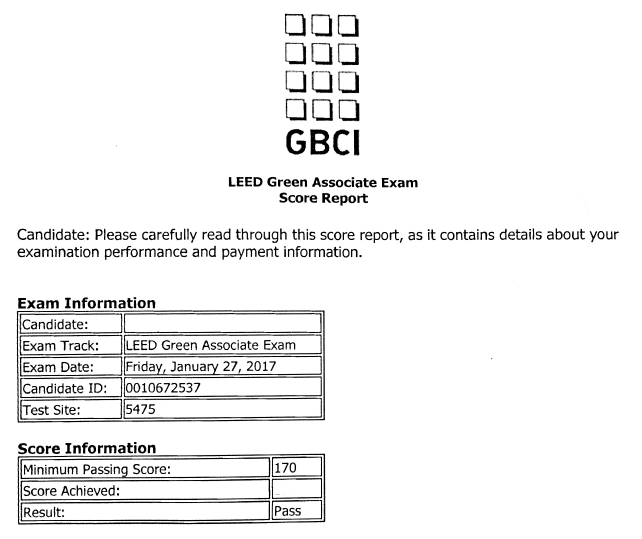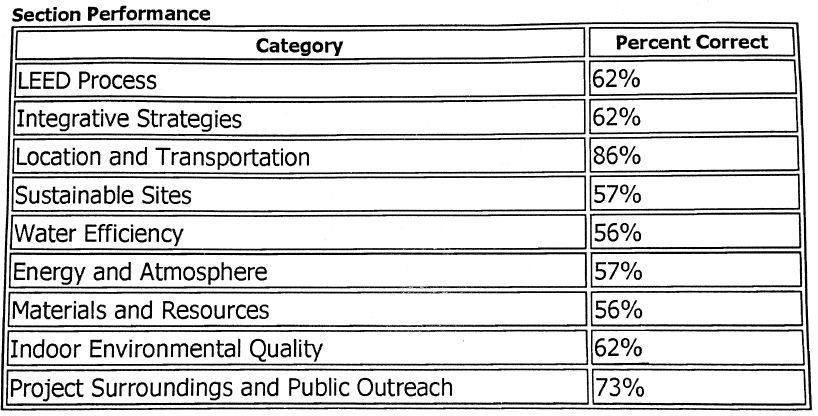No products in the cart.
LEED Exam Documents & Resources that Prove You Passed
Pursuing a LEED professional credential can be a daunting and overwhelming endeavor for some individuals. Those who put in the time to study the LEED credits, baseline measurements, and case studies, however, will likely find themselves in a successful position. And after all that hard work, you definitely want to show off your achievement. We’re going to talk to you today about the LEED exam documents that you can share with employers and clients to prove that you are, in fact, a LEED Accredited Professional.
If you’re just getting started with LEED, visit our New to LEED? Start Here! series.
The LEED exams are administered by computer, though candidates must be proctored in person at a Prometric Testing Center. Prometric has facilities in nearly every major city in the world, and candidates are able to choose the exact date and time of their exam session based on Prometric’s availability in the computer lab.
Your LEED Exam Score
Because the exams are digital, candidates will know their score immediately after they end the exam. Individuals will receive a printed sheet of paper that lists their score out of 200 possible points and whether that score has resulted in a Pass or Fail. This LEED exam document is a great resource to show your friends and colleagues to represent your understanding of LEED.
When it comes to sharing the news of a passing score, individuals do not need to focus on the actual point value of their results. The green building world, employers, and clients will not ask what point value was achieved on the LEED exam. All that matters is that the candidate Passed.

The printed LEED exam document will also share proficiency results for each of the LEED Credit Categories. This information is debatably more valuable to candidates who Fail the exam because it gives them feedback on which specific LEED areas to focus on for future exam attempts.
On the other hand, new credential holders can use this information as a guide for LEED continuing education efforts. All LEED credential holders must complete continuing education every 2 years to maintain their professional credential; it could be a wise idea to explore these weaker areas for professional development.

Before a new credential holder leaves the secure testing environment, a Prometric staff member will notarize the printed exam results. This can serve as temporary proof that an individual passed the LEED exam. The USGBC will make the official LEED certificate available within 48 hours.
Accessing Your LEED Certificate
The USGBC encourages credential holders to stay green by downloading their official certificate. With the digital copy, an accredited professional can email the certificate, upload to social media/websites, and/or print from home. Upon request, GBCI will mail a printed copy for a $25 fee. This request can be made from inside an individual’s USGBC account.
To log into your USGBC account and download your certificate, go to:
- www.usgbc.org
- Click the Account link in the top right
- Add the username and password from your exam registration
- Navigate to the Credentials tab in the left sidebar
- Choose the Overview link in the left sidebar
- Midway through the page, you’ll see Download Certificates
The USGBC updates its platform somewhat regularly. If you’re unable to find your official certificate within your USGBC Account, you can call the USGBC directly at 800-795-1747 (U.S.) or 1-202-742-3792 (outside the U.S.).
LEED Credential Maintenance
As mentioned above, all LEED credential holders are required to participate in continuing education. The LEED professional credentials are valid for 2 years at a time.
LEED Green Associate credential holders must earn 15 hours of continuing education, with 3 of those hours specific to LEED concepts. LEED AP Specialty credential holders must earn 30 hours of continuing education, with 6 of those hours specific to their LEED AP specialty track.
You’ll also notice on the Credentials Overview page of your USGBC Account that there is a gray box at the top of the screen. This gray box defines a credential holder’s “reporting period” – in other words, the time period in which the earned credential is valid. A credential holder must earn all of his or her continuing education hours during this time period.

When it comes to submitting LEED continuing education hours to USGBC, a credential holder must know his or her GBCI number. This number is specific to each credential holder, thus it enables USGBC to attribute the continuing education hours to the correct individual.
Please note: some individuals will have a Member ID# and a GBCI#.
The Member ID# is only applicable to individuals who work for a USGBC National Member Company. This ID# is shown at the top of your USGBC Account. This affiliation is valuable to employees because they can get a $50 discount on their LEED exam registration.
You’ll see in the above screenshot that the GBCI# is shown on the Credentials Overview page as well. This will be the ID# you use when submitting your continuing education.
Now that you’re a newly accredited LEED Green Associate or LEED AP, share the news with your colleagues and associates! Check out our post on 14 ways to flaunt your LEED credential. Be proud of your accomplishment!
When you’re ready to participate in continuing education, Everblue offers a comprehensive online program that is specifically designed to satisfy the LEED Credential Maintenance Program requirements for LEED Green Associates and LEED APs with a Specialty.